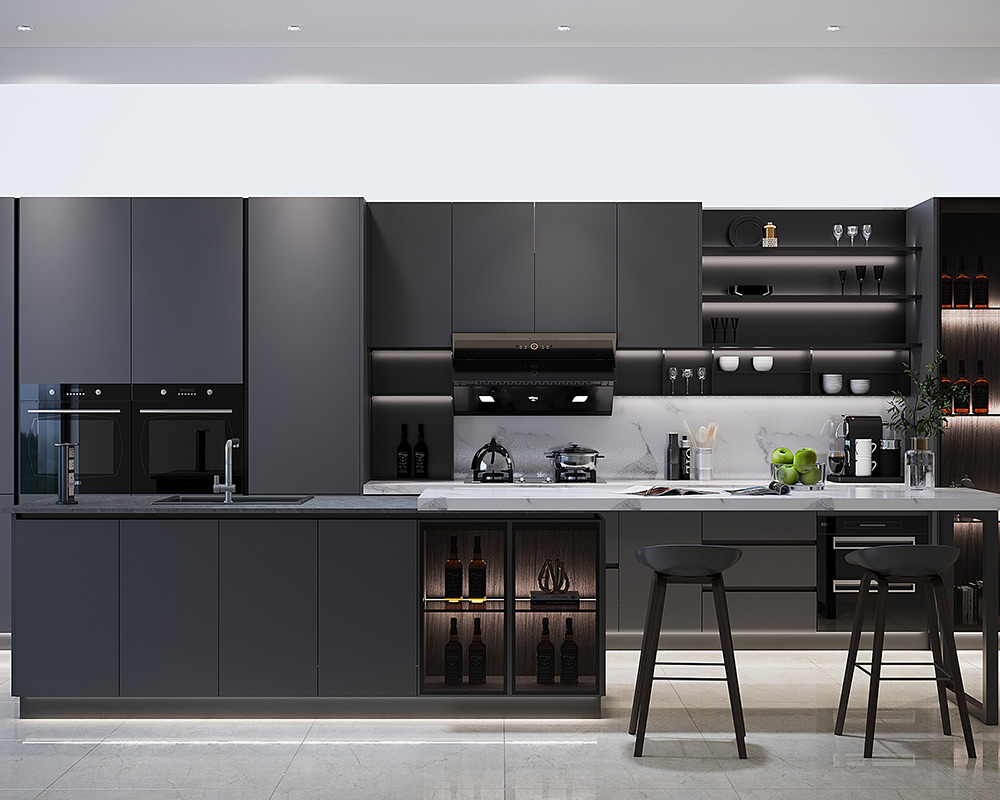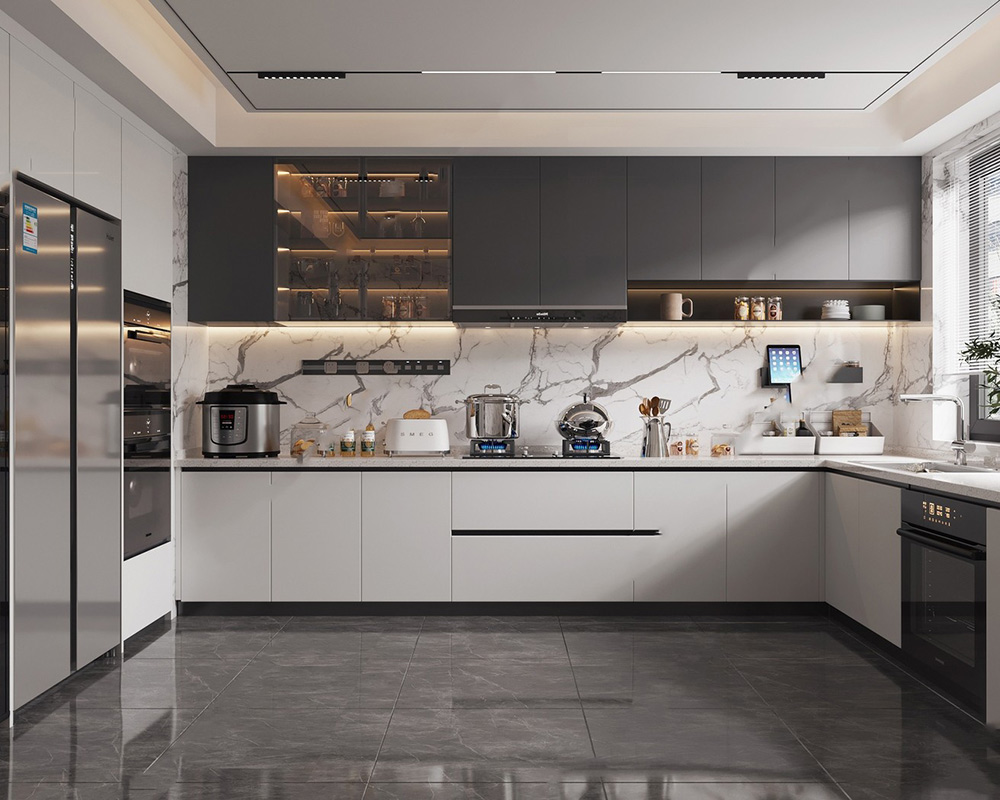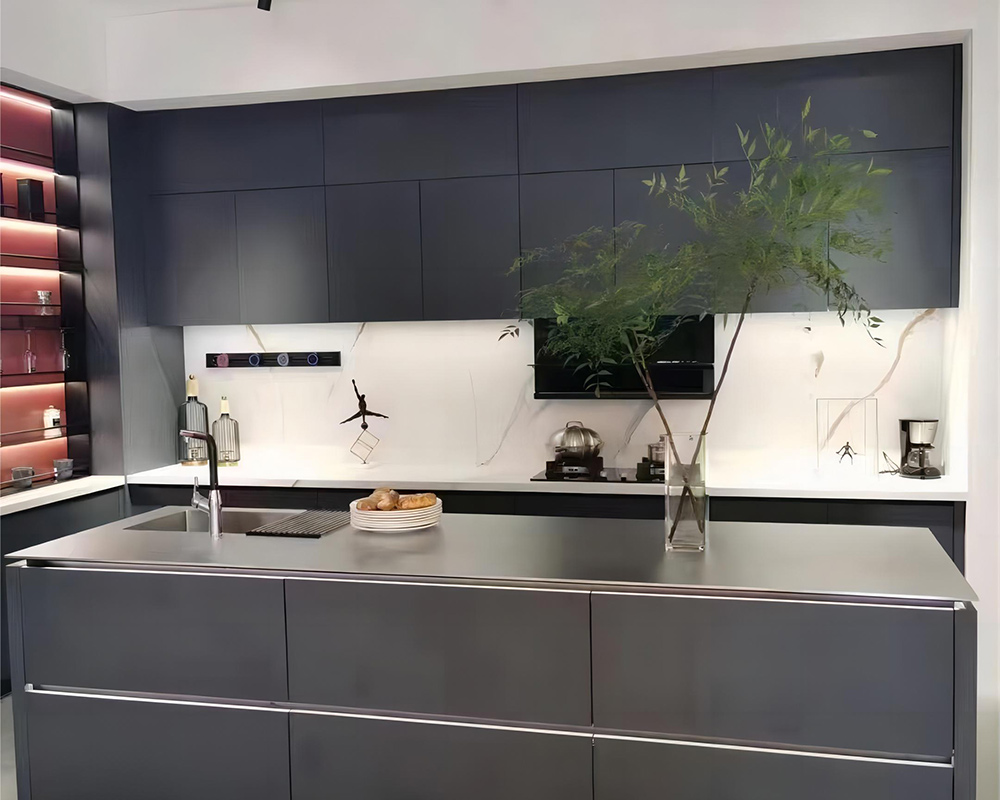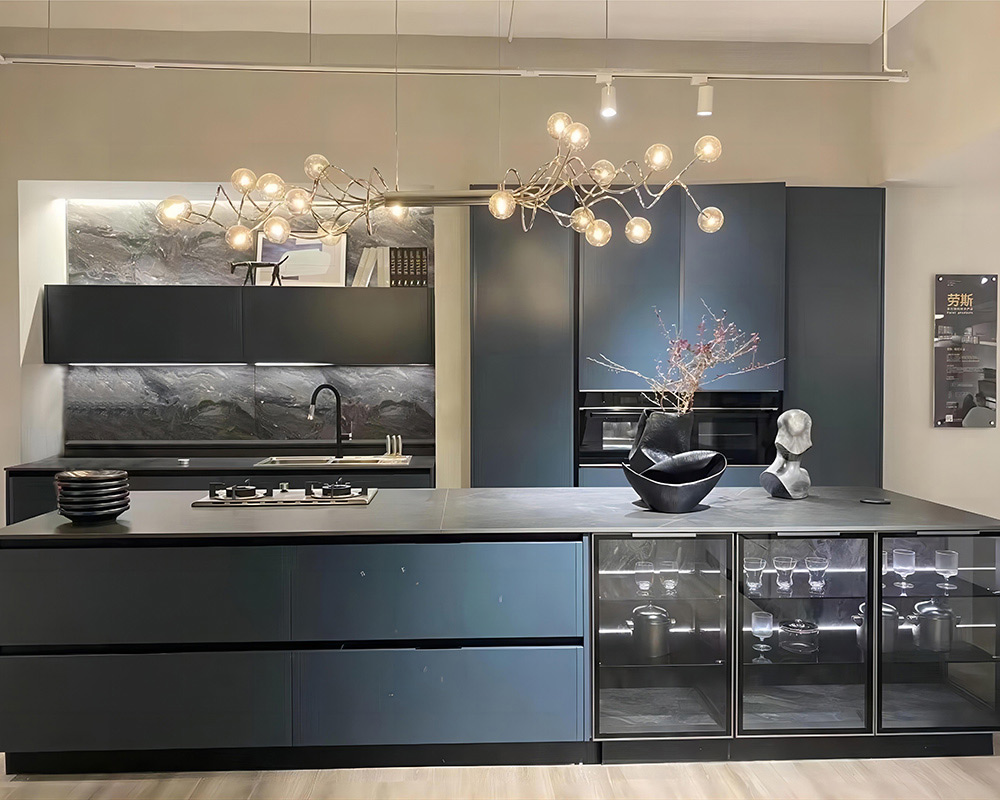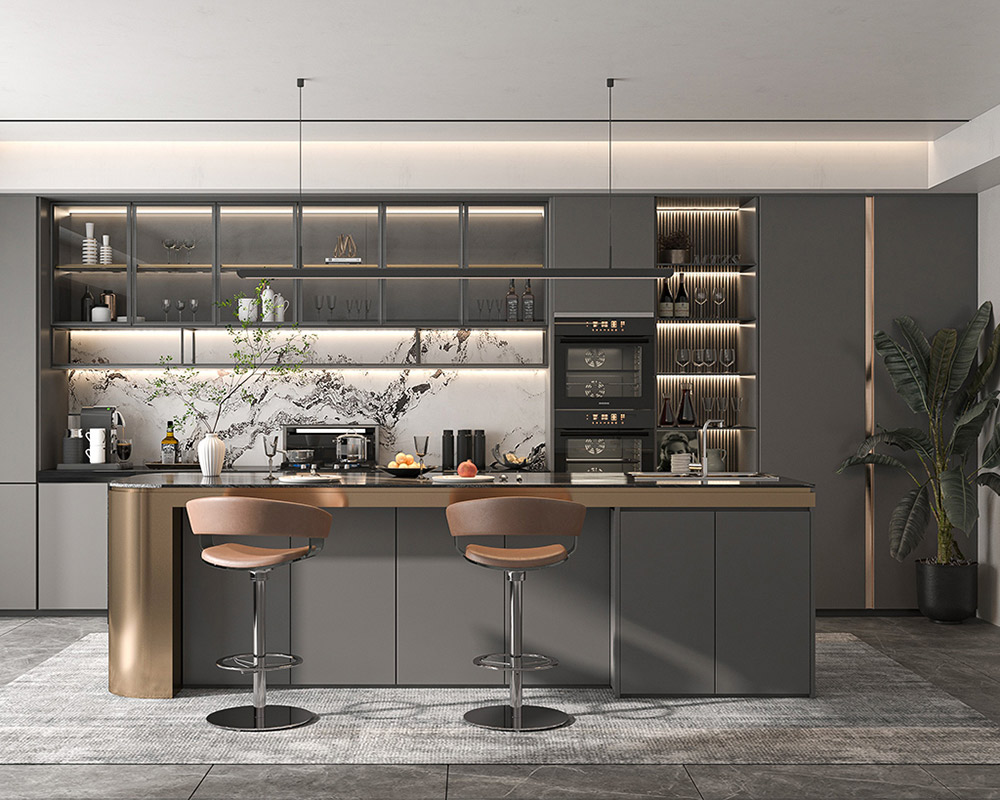Product Description
This 304 Stainless Steel Kitchen Cabinet is a kitchen storage and operation integrated furniture, designed to provide a durable, hygienic and beautiful storage solution and comfortable cooking operation space for the kitchen. Its cooking operation is smooth and the countertop is spacious, allowing users to easily prepare ingredients and cook. In addition, it is durable and remains sturdy and beautiful even after long-term use, which can meet users' dual needs for kitchen functionality and beauty.
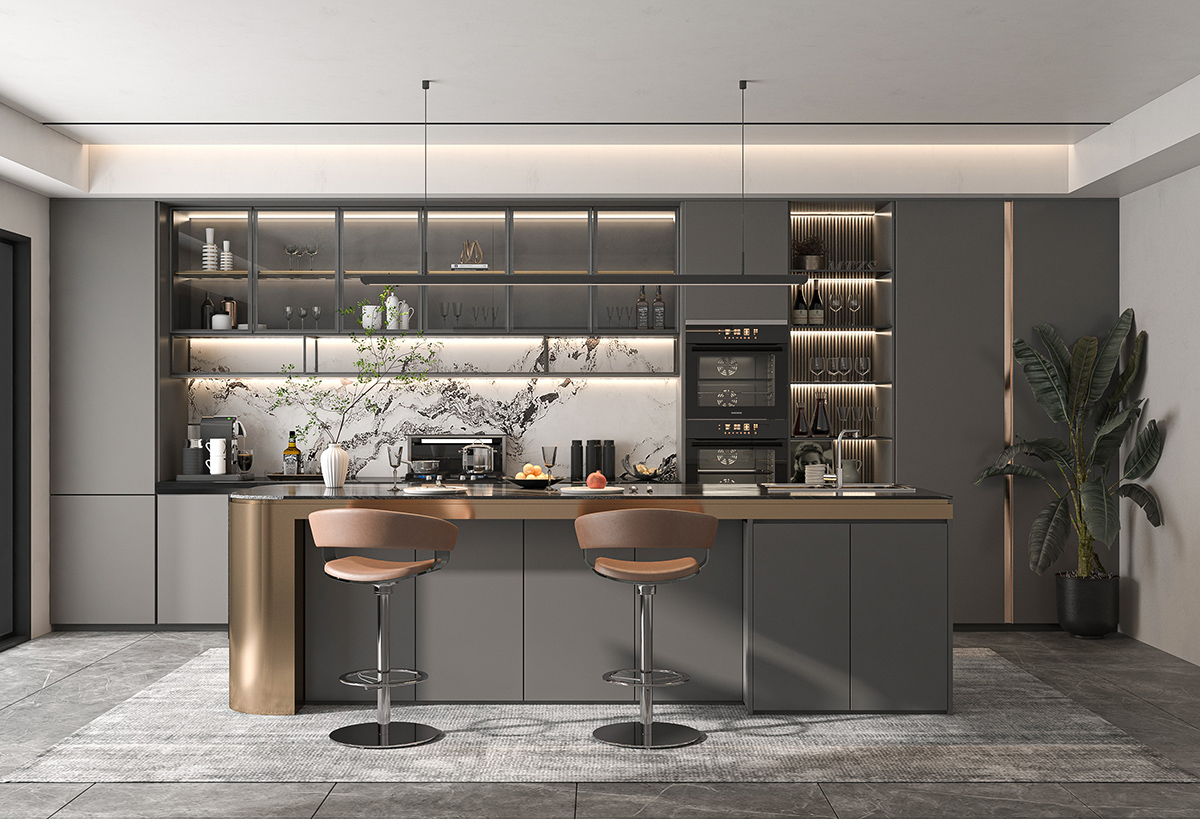
304 Stainless Steel Kitchen Cabinet Specifications:
| Item | Parameters |
| Product No. | KC008 |
| Standard Size | W4000*H810*D600mm |
| Technology | Food-Grade Countertops With One-Piece Baked Enamel Tops |
| Material | 304 Stainless Steel |
| Colors | Grey |
| Factory Nature | China Manufacturers Suppliers Factory |
304 Stainless Steel Kitchen Cabinet Features:
1. Strong corrosion resistance:
304 Stainless Steel Kitchen Cabinet contains 18% - 20% chromium and 8% - 10.5% nickel, which can form a dense oxide film on the surface to resist acid and alkali corrosion. In the simulated kitchen acid and alkali environment test, after 72 hours of contact with common vinegar, detergent, etc., the surface corrosion rate is less than 0.002 mm/year, far exceeding the 0.05 - 0.2 mm/year of ordinary carbon steel cabinets, and the service life is up to 15 - 20 years.
2. Excellent load-bearing capacity:
The cabinet structure is reinforced and can withstand 200 - 300kg of evenly distributed weight. Multiple kitchen appliances and food ingredients can be placed on a daily basis without deformation or damage, providing a stable platform for kitchen operations.
3. Antibacterial and easy to clean:
The surface of 304 stainless steel is smooth and seamless, and the bacterial residue is 80% - 90% lower than that of wooden cabinets. Just wipe with a damp cloth for 3-5 minutes, then wipe with a dry cloth to remove more than 95% of daily stains, and the cleaning efficiency is 60%-70% higher than that of ordinary cabinets.
4. Fire retardant:
The ignition point of 304 stainless steel cabinets exceeds 1500℃, which is much higher than the common temperature of kitchen fires of 300-500℃. The experiment was exposed to 800℃ flame for 30 seconds, with only slight discoloration and no burning, providing high-level fire protection.
5. Accurate size adaptation:
The standard size is 4000mm wide × 810mm high × 600mm deep, which is ergonomic, and the operating table height of 810mm is suitable for most people to cook. The width and depth can be flexibly adjusted, with a customized error within ±5mm. After installation, it fits the wall and electrical appliances tightly, improving space utilization by 15%-20%.
6. Beautiful and durable:
The glossiness reaches 60-80 GU, with a high-grade gray texture, which fits the modern and simple decoration styles. After more than 10,000 switch and touch simulation experiments, there is no obvious wear on the surface and structure, and it remains beautiful and practical for a long time.
7. High space utilization:
The internal layout is reasonable, with a variety of storage spaces, such as pull-out baskets and drawers. It can store tableware, seasonings and other items in a classified manner, effectively utilize space, and store 15%-20% more items than ordinary cabinets, making the kitchen neat and orderly.
8. Excellent antibacterial performance:
The antibacterial rate of 304 stainless steel cabinets exceeds 90%, inhibiting bacterial growth and preventing food contamination. In a humid kitchen environment, its antibacterial performance is stable, ensuring the health of family diet.
9. Convenient installation:
The 304 stainless steel cabinet adopts a standardized design, with a universality of 80%-90% of parts and components. The installation steps are simple and can be completed using common tools such as screwdrivers. Two installers can install a complete set of cabinets within 3-4 hours, saving time and labor costs.
10. Environmental protection and health:
304 stainless steel cabinets meet strict environmental protection standards, and no harmful substances such as formaldehyde and benzene are added during the production process. Its heavy metal content (lead, cadmium, etc.) is 1/10 lower than the national safety limit, and it is harmless to use for a long time, creating a healthy kitchen environment for the family.
Application of 304 Stainless Steel Kitchen Cabinet:
Home kitchen: In the home kitchen, 304 Stainless Steel Kitchen Cabinet can be used as core storage and operation furniture. Its large storage space can accommodate all kinds of kitchen utensils and ingredients. The multi-layer drawer and partition design allows tableware and knives to be stored in different categories for easy access. The spacious countertop can accommodate multiple cooking processes at the same time, such as preparing food, cooking, baking, etc., which improves cooking efficiency and is suitable for families who pursue healthy diet and cooking quality.
Hotel kitchen: Hotel kitchens need to be used for a long time and with high intensity. The corrosion resistance and easy cleaning characteristics of 304 stainless steel cabinets meet their hygiene standards. It can withstand the busy rhythm of the back kitchen and will not be damaged even after multiple cleaning and disinfection every day. Its antibacterial properties ensure the safety of food storage. Large hotel kitchens are equipped with multiple sets of 304 stainless steel cabinets for different functional areas, such as cutting and preparing areas, cooking areas, and food preparation areas, to improve overall operational efficiency.
School canteen: The school canteen is related to the food safety of many students. The antibacterial and fire retardant properties of 304 stainless steel cabinets are particularly important. The smooth and seamless surface can effectively prevent the accumulation of food residues and stains, reduce the growth of bacteria, and provide students with hygienic dining guarantees. Its stable structure can carry a large number of kitchen utensils and ingredients to meet the needs of centralized catering.
Hospital kitchen: Hospital kitchens have strict hygiene requirements, and the antibacterial and easy-to-clean characteristics of 304 stainless steel cabinets meet the needs of medical environments. In the special environment of hospital kitchens, it can prevent cross-contamination and ensure the health of patients' diets. Its corrosion resistance can resist the erosion of disinfectants, ensure long-term stable use, and provide reliable logistical support for hospitals.
Ship kitchen: Ship kitchens face harsh marine environments such as humidity and salt spray. The excellent corrosion resistance of 304 stainless steel cabinets enables it to be used for a long time in an environment with a salt spray concentration of up to 5% - 10%, and there is no obvious rust on the surface. Its stable structure can resist the shaking and bumping of the ship during navigation, ensure the stability of kitchen facilities, and provide safe and reliable cooking conditions for crew members.
Laboratory kitchen: In laboratory kitchens such as food research and development and testing, 304 stainless steel cabinets can resist the erosion of various chemical reagents. Even if the acid and alkali solutions, organic solvents, etc. used in the experiment accidentally drip, it will not cause damage to its surface, ensuring a clean experimental environment and accurate data, providing professional protection for scientific research work.
304 Stainless Steel Kitchen Cabinet Maintenance:
Daily cleaning and maintenance: Wipe the surface of 304 stainless steel cabinets with a soft, slightly damp cotton cloth regularly to remove dust and stains. For stubborn stains, use a neutral detergent (such as detergent diluted with water in a ratio of 1:10) to gently wipe, then rinse with clean water and wipe dry. Avoid using rough scouring pads or strong acid and alkali cleaners to prevent scratching the surface. Cleaning 1-2 times a week can keep the cabinets as bright and clean as new for a long time.
Regular deep maintenance: Deep maintenance of the cabinets every quarter, use a special stainless steel cleaner, first spray the cleaner evenly on the surface, leave it for 3-5 minutes, wipe it along the stainless steel texture with a soft cloth, then rinse with clean water, and finally wipe it dry with a dry cloth. This cleaning method can effectively remove long-term accumulated stains, restore the surface gloss, and keep the cabinets in good appearance after years of use.
Timely treatment of water stains and oil stains: Water stains and oil stains splashed on the cabinets during cooking should be cleaned in time. Long-term water stains will cause watermarks on the stainless steel surface, and oil stains will gradually accumulate and harden, making them difficult to clean. You can sprinkle a little detergent on the oily area, wipe it gently with a damp cloth, and then wipe it dry with a dry cloth to prevent the oil stains from eroding the cabinet surface and maintain its beauty and performance.
Avoid hard objects hitting: During kitchen activities, be careful to avoid hard objects such as spatulas and heavy objects from falling and hitting the cabinet. Although 304 stainless steel is strong, it may still be deformed or scratched by strong impact. When operating near the cabinet, handle objects with care. If you find slight scratches or deformations, contact professional maintenance personnel in time for repair to prevent the problem from expanding.
Check hardware regularly: Check the hinges, slides and other hardware of the cabinet every month for looseness. If you find looseness, tighten it with a screwdriver in time; if the hardware is rusted, apply a small amount of lubricating oil to restore it to normal operation. Regular inspections can ensure that the cabinet doors open and close smoothly, the drawers can be pushed and pulled freely, and extend the service life of the cabinet.
Pay attention to moisture-proof ventilation: The kitchen is humid, so keep the cabinet area well ventilated to avoid long-term moisture. You can place a desiccant (such as silica gel desiccant) at the bottom or inside the cabinet and replace it every 1-2 months. Ventilation and desiccant can effectively prevent condensation on the stainless steel surface and reduce the risk of moisture damage to the cabinet.
304 Stainless Steel Kitchen Cabinet FAQ:
What is a 304 Stainless Steel Kitchen Cabinet?
A 304 Stainless Steel Kitchen Cabinet is a type of cabinetry designed to showcase and store kitchen items such as dishware, cookware, utensils, and decorative pieces. It often features glass doors or open shelving to allow for easy viewing of the contents.
What are the benefits of using a 304 Stainless Steel Kitchen Cabinet?
Showcasing Items: Allows you to display attractive dishware and decorative items.
Organized Storage: Keeps frequently used kitchen items within easy reach.
Aesthetic Appeal: Enhances the overall look of the kitchen with a sleek and modern design.
Durability: Made from robust materials that can withstand daily use.
How do I maintain and clean a 304 Stainless Steel Kitchen Cabinet?
Stainless Steel: Clean with a mild detergent and water for regular maintenance. Use a stainless steel cleaner for tougher stains. Avoid abrasive cleaners and tools that can scratch the surface.
Glass: Use a glass cleaner to keep the doors and shelves sparkling clean.
Wood: Wipe with a damp cloth and mild cleaner. Avoid excessive moisture to prevent damage.
How are 304 Stainless Steel Kitchen Cabinets installed?
Installation typically involves securing the cabinet to the wall using screws and brackets. It is recommended to have professional installation to ensure stability and proper alignment.
How do 304 Stainless Steel Kitchen Cabinets improve kitchen efficiency?
By providing organized storage for kitchen items, kitchen display cabinets help streamline kitchen workflows, making it easier to find and access items quickly, thus enhancing overall kitchen efficiency.
How can I maximize the space in my 304 Stainless Steel Kitchen Cabinet?
Adjustable Shelves: Use adjustable shelves to accommodate items of varying sizes.
Organizers: Utilize organizers and dividers to keep items neatly arranged.
Lighting: Install cabinet lighting to highlight displayed items and improve visibility.

